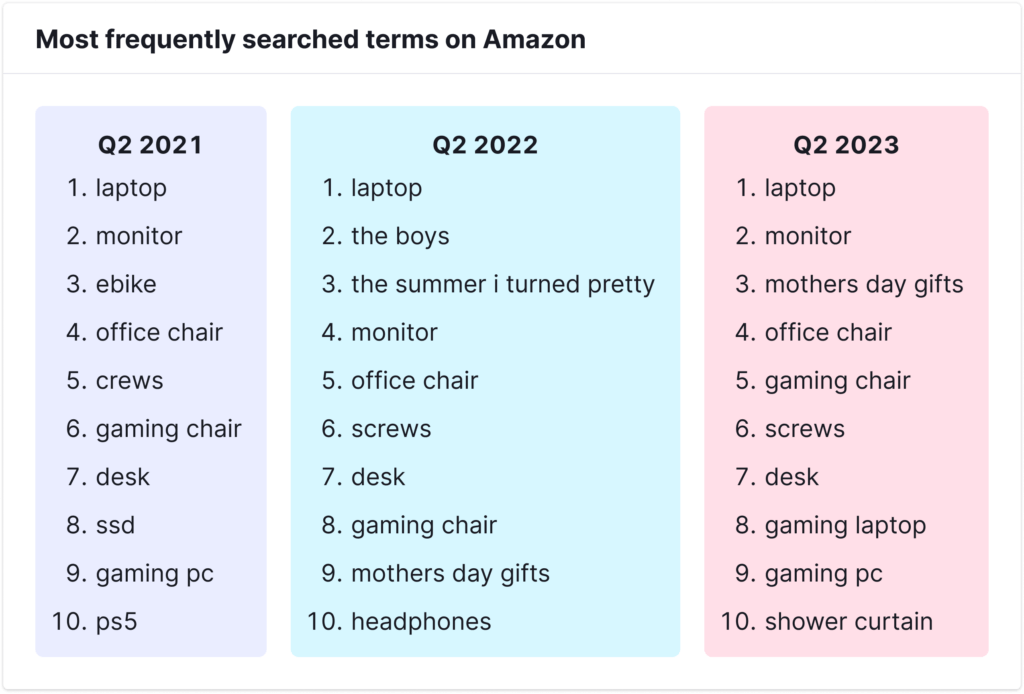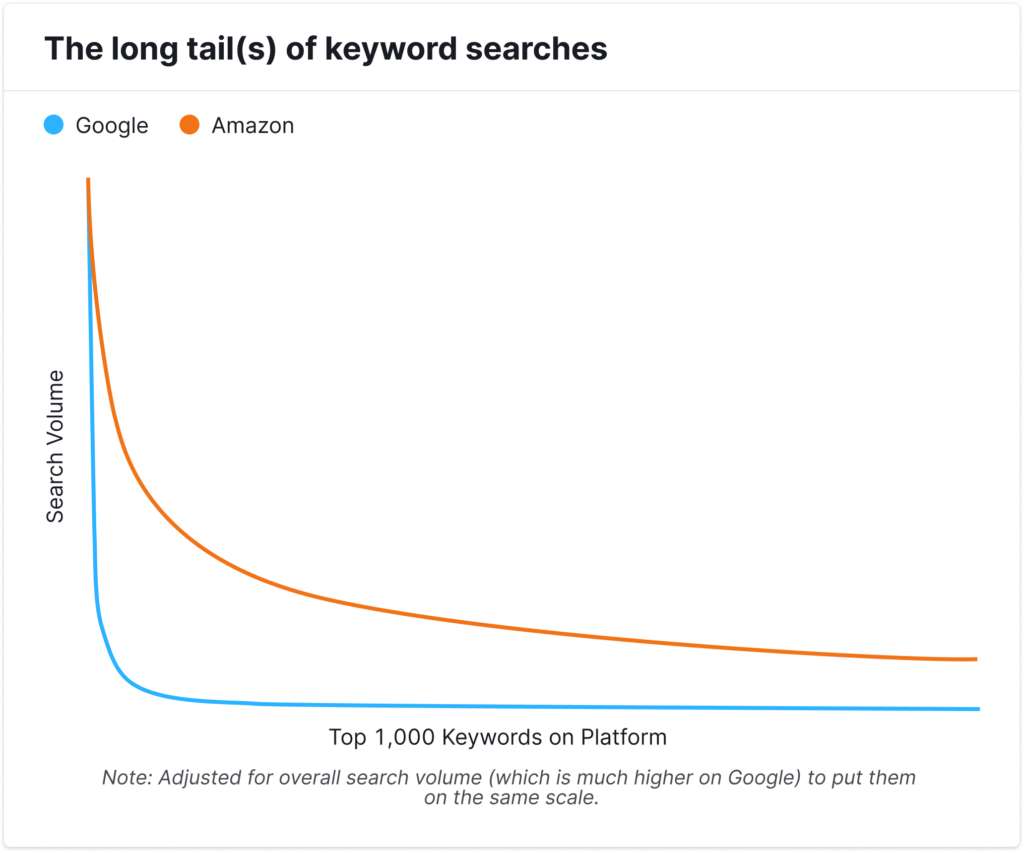We’ve all heard that what happens in Vegas, stays in Vegas. Today’s tech parallel: data about what happens on Amazon largely stays within Amazon. Like so many big sites, Amazon is a walled garden. Within it are the secrets of their valuable (and closely guarded) first-party data.
I wanted to peer into that walled garden to better understand what people search for on Amazon, and contrast that with how people search for things on Google. So I worked with Datos, widely known for its global opt-in consumer panel with anonymized, privacy compliant datasets. Together we examined the top 1,000 search terms on Amazon each quarter from Q2 2023 back to Q4 2020. (We also looked at the top 1,000 search terms on Google – more about that in a separate post).
Amazon is a hub for utilitarian purchases
While top search terms on Google are largely brand names and frequently visited sites, searches on Amazon search are largely focused on unbranded and utilitarian products. On Amazon, people are searching for the commodities of everyday life, particularly our tech commodities. Laptop is consistently the top search term, with monitor, office chair, and desk consistently in the top 10. Gaming chair and gaming laptop also rank highly, with headphones and SSD (solid state drives) making occasional appearances in the top 10.
In tech and beyond, top search terms are for highly generic and practical products. Screws consistently ranks #5 or #6, with desk a consistent #7. Shower curtain makes an appearance. Air fryer and protein powder rank just outside the top 10. Luggage, car accessories, TV stand, travel essentials all rank in the 30s.

Conspicuous by their absence: Brand names
In categories where no brand stands out, and there seems little benefit to paying a premium for a specific brand, Amazon becomes the go-to destination.
Consider tech. Laptop ranks #1, but only two computer brands rank in the Top 1,000 – Lenovo laptop (#674) and Dell laptop (#728). Absent are Hewlett Packard, IBM, Acer and a host of other computer brands heavily featured on Amazon. To borrow a line from an old advertisement, it takes a strong distinctive brand for consumers to “ask for it by name.” A few examples of brands breaking through on Amazon:
- Gaming brands stand out, with branded gaming hardware platforms ranking particularly highly when a new model comes out. Nintendo Switch ranks #11 in Q2 2023, and PS5 hit #10 in 2021.
- Apple products are found throughout the list (various models of iPhone, iPad, MacBook, and Apple Watch – plus their associated cases and accessories)
- Amazon brands unsurprisingly do well (Alexa, Kindle, Fire, Ring)
- Shoe brands stand out – Crocs ranks #23, and Nike ranks #125, with Birkenstock, Adidas and New Balance also making the Top 1,000
Top searches in most categories are devoid of brand names. Consider clothing. The top searches are men’s shorts (#39) and women’s summer tops (#46), followed by a host of other generic searches. But brands are almost entirely absent. The quasi-branded search for polo shirts for men ranks #412, but this probably refers to “polo” more as a type of shirt than the Ralph Lauren brand. Lululemon as a standalone term ranks just outside the Top 1,000, far behind Lululemon dupes (#604; search volume up over 200% from a year ago).
A smattering of other brands make the list, typically those that are so category-defining that the brand name becomes almost synonymous for the category itself. Examples include Lego, Brita, Keurig, Oral-B, and Dyson
Search Terms on the Rise
The most consistently rising Amazon search term is mother’s day gifts, which ranked #149 just two years ago, before rising to #9 last year and #3 this year. Seven related search phrases also appear in the Top 1,000, including mother’s day gift ideas (#68), mother’s day gift basket (#368), mother’s day gifts for wife (#297), and mothers day gift basket (#368). Father’s day gifts shows a similar if less dramatic increase, with fewer permutations (and there is a Father’s Day gifts from son, but no Father’s Day gifts for husband).
In 2020, Amazon reportedly canceled planned promotions for Mother’s Day and Father’s Day, as they struggled to fulfill purchases as pandemic shutdowns took hold. Now Amazon consistently promotes the holiday with Mother’s Day gift guides and more. And as the search terms suggest, they are trying to broaden the scope of who should be in the market (mother’s day gifts for wife). Frankly, it is a holiday whose gift-giving traditions are ripe for reinvention – replacing over-priced, unreliably-delivered flowers with the reliability and practicality of Amazon.
Many of the ebbs and flows in search volume are related to releases of new technology models (e.g., the latest iPhone), and to releases of new entertainment content. For example, In Q2 2022, releases of Amazon Prime shows The Boys and The Summer I Turned Pretty caused related searches to crack the Top 10. New game releases follow the same pattern, with Zelda, Diablo 4 and others seeing recent spikes in searches. Much less common are searches related to new product launches (a notable exception: Skechers Slip-Ins).
Amazon sells everything and the kitchen sink. Searches for kitchen sink up dramatically in the past year. Also up big: kitchen faucets, bathroom faucets, bathroom sinks, vanity, closet organizer, and outdoor lights. Clearly Amazon has set its sights on one of the few retailers who can take them on head-to-head in a category: Home Depot.
Rising search terms also highlight that the Taylor Swift economy is in full swing on Amazon. Beyond searches for the artist herself, searches for Taylor Swift concert outfit rose from essentially zero to nearly half a million in the most recent quarter.
The (somewhat) long tail of Amazon searches
Finally, it is worth noting that the distribution of Amazon keyword searches is somewhat different from searches on Google. Google searches are dramatically long-tailed – meaning that search volume is massive for the most popular terms (the “head” or “fat” part of the distribution), and drops off quickly, stretching out into a long tail. Analysis shows it is extremely long-tailed, and getting longer over time.
In contrast, although the distribution of Amazon searches is generally the same shape, it is much flatter and less dramatic. On Amazon, the falloff after the top few terms is not as steep, and search interest is more widely dispersed across a variety of terms.
The take-away: there is no marketplace category or product that defines our consumer lives in the same way that YouTube, Facebook and Gmail define our digital lives.





